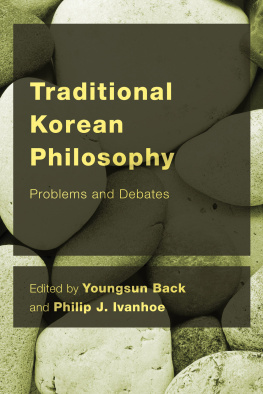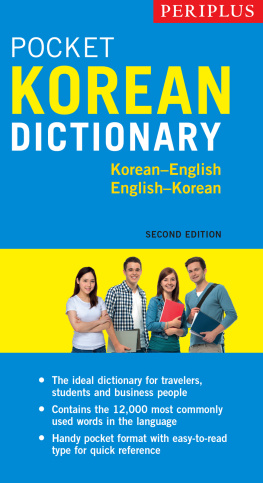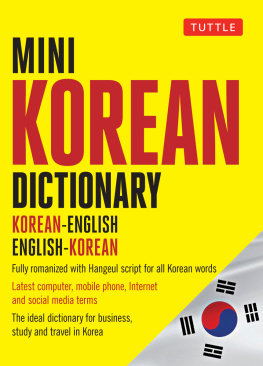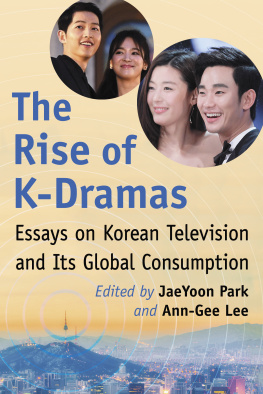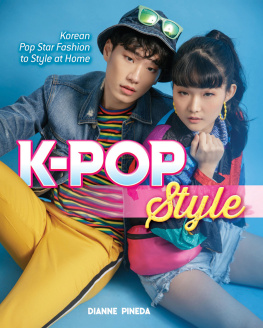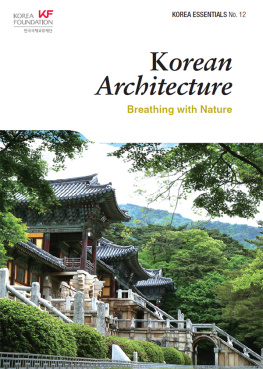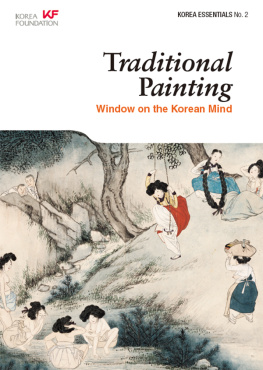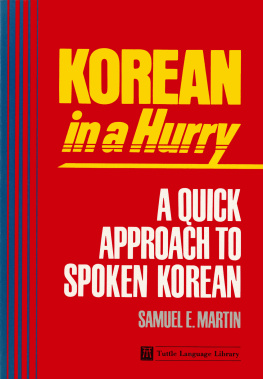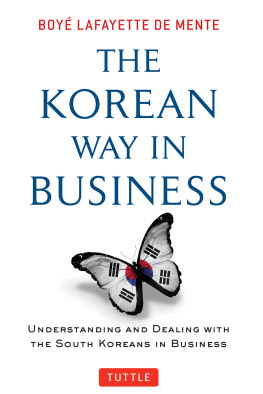KOREA ESSENTIALS No. 16
No part of this book may be reproduced or utilized in any form or by any means without the written permission of the publisher.
Published in 2013 by Seoul Selection B1 Korean Publishers Association Bldg., 105-2 Sagan-dong, Jongno-gu, Seoul 110-190, Korea Phone: (82-2) 734-9567
CONTENTS
Delving Deeper

INTRODUCTION
Hanbok, or traditional Korean attire, is the unique costume of the Korean people that has preserved its original form throughout much of the nations long history. Although largely worn today for traditional holidays and special occasions such as a wedding or a childs first birthday, hanbok is often considered the quintessential cultural heritage of Koreans and the most visible form confirming their national identity and roots.
Hanbok embodies many of the social and aesthetic values of the Korean people. In accordance with the emphasis on social harmony found in Confucian philosophy, the choice of hanbok varied depending on ones position in society. Its beautifully flowing lines and harmonious color schemes are important aesthetic values found in Korean art.
Hanbok is increasingly expanding its global presence due to the popularity of Korean TV dramas, especially those set in the nations past, and also through promotional efforts on the world stage. Renowned fashion designers throughout the world have used elements of hanbok in their own works.
This book will examine the origins, history, and the unique characteristics of hanbok and contemporary standing of the attire to give readers a deeper understanding of Korean culture, history, and its people. Hanbok is something more than just everyday clothes. Rather, it should be considered as a cultural artifact that provides a window to Korean identity and cultural heritage.

Fashion is only the attempt to realize art in living forms and social intercourse.
- Francis Bacon

Hanbok, which literally means Korean clothing, is largely worn in Korea today for traditional holidays and special occasions such as a wedding or a childs first birthday. But such attire is also seen nearly daily on primetime television through popular Korean historical dramas set when hanbok was what people wore every day. Hanbok has been the attire of Koreans since recorded history. Though undergoing changes over the years in design and arrangement, hanbok has had its essential form stay intact. Such costumes have also been a critical component of how social order was kept through successive dynasties over two millennia, thus learning the history of hanbok provides a unique view into Korean history.
Hanbok is also seen as the epitome of Korean aesthetics. It is simple, yet elegant; humble in form, but opulent in expression. Relying on simple primary colors to create a colorful and vibrant appearance, hanbok is focused on the beauty of lines, silhouette, and space that are also found in other Korean arts. Understanding the aesthetic principles underlying the clothing line leads to a better understanding of the core values in the Korean concept of beauty.
HISTORY OF HANBOK
The Three Kingdoms Period
Hanboks origins can be traced back to the Three Kingdoms period (57 BCAD 668) when Goguryeo, Silla, and Baekje occupied the northern, southeastern, and southwestern parts of the Korean Peninsula, respectively. Artifacts show both men and women wearing the jeogori, or upper garment. Men wore wide and roomy trousers called baji, and women were clad in chima, or long skirts.

Koreans today often wear hanbok during traditional holidays such as Seollal and Chuseok.

Gamudo from Muyongchong, Goguyeo-period grave
The length of the jeogori stretched to the hip and had wide, extended sleeves. This garment was folded on the left side, and the neckline, sleeve cuffs, hem line, and the front opening were sewn with bindings of different colors. The ways in which a jeogori was folded underwent changes over the years. Initially, the frontal folds of the jeogori closed at the front center similar to a caftan, then changed to the left side, and finally to the right, a practice accepted as the standard since the sixth century AD.
A womans jeogori showed variation in length and width of the sleeves. A Goguryeo mural estimated to date back to the late fifth century shows a womans jeogori as shorter in length than a mans, with shorter and narrower sleeves. Other murals also support the idea that jeogori had varying lengths throughout the Three Kingdoms period.
At the time, a jeogori was fastened at the waist using a ttwi, a sash-like belt. But over time, as the length of the jeogori decreased over the Goryeo (9351392) and Joseon (13921897) periods, a jeogori was fastened using a goreum, an extending ribbon tied up on the right side in conjunction with the closing of a jeogori.
The type of baji worn by Goguryeo men showed great diversity in style. From a holtae baji (tight-fitting pants) to a daegugo (long pants with wide room in the crotch) and jambang-ee (unlined shorts), the differing styles catered to different uses and occasions. Murals from the Goguryeo period depict both men and women wearing baji under the outer garment or under the womens skirt chima. The roomy nature of baji suited the Goguryeo people, who were nomadic and often rode horses.
Murals also show that both men and women wore chima. The type worn by both for formal occasions was sang and that worn only by women was goon, which had long and wide dimensions. The origin of durumagi, the long outer coat worn over a jeogori, goes back to the Goguryeo period. The durumagi emanates from the long coat worn by northern Chinese to fend off cold weather in ancient times. The long coats reached mid-calf and had bindings similar to those used for jeogori. Later, this was adopted by the Goguryeo upper class in various forms for ceremonies and rituals, and the modified form worn by the general populace came to be known as durumagi.



